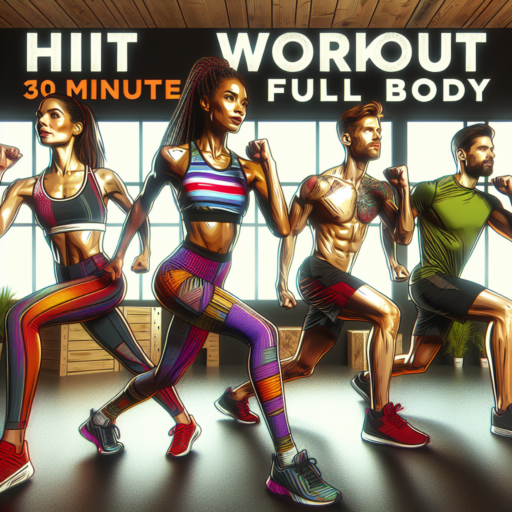Are 30-minute HIIT workouts effective?
High-Intensity Interval Training (HIIT) has risen in popularity for its purported benefits in achieving quick and effective fitness results. A common question many individuals face is whether 30-minute HIIT workouts are effective enough to meet their fitness goals. The answer lies in how these workouts are structured and the intensity level one is able to maintain throughout the session.
HIIT workouts, by design, are meant to push your body to its limits in a short amount of time. This is achieved through quick bursts of intense activity followed by brief periods of rest or lower-intensity exercise. The effectiveness of 30-minute HIIT sessions hinges on this high level of intensity. Research suggests that these shorter workouts can not only improve cardiovascular fitness but also enhance metabolic rates, leading to increased fat burning.
Key Components of an Effective 30-Minute HIIT Workout
- Warm-up: A 5-minute warm-up to prepare your body for the intense activity ahead.
- Intervals: Varying the intensity and type of exercises to target different muscle groups.
- Cooldown: A short period to lower your heart rate and stretch the major muscle groups.
Including a variety of exercises in your 30-minute HIIT routine can help ensure that you are engaging multiple muscle groups, maximizing the effectiveness of your workout. Additionally, the adaptability of HIIT workouts means they can be modified to suit different fitness levels, making them an accessible option for many individuals looking to improve their health and fitness.
How many calories does 30 minutes of HIIT burn?
The number of calories burned during a 30-minute session of High-Intensity Interval Training (HIIT) can vary widely depending on several factors, including the intensity of the workout, the individual’s weight, and their metabolic rate. Generally, HIIT is recognized for its effectiveness in burning a high number of calories in a short period. On average, individuals can expect to burn between 250 to 500 calories in a 30-minute HIIT session. This range represents a broad average and the specific number of calories burned can be higher or lower based on personal factors.
One of the key reasons HIIT is so effective at burning calories is due to the phenomenon known as the afterburn effect, or post-exercise oxygen consumption (EPOC). This effect means that your body continues to burn calories at an elevated rate even after the workout has ended. The intensity of HIIT workouts pushes your body to work harder to replenish the oxygen and energy lost during exercise, thus increasing your overall calorie burn.
To maximize calorie burn during HIIT, incorporating a variety of high-intensity exercises is crucial. Activities such as sprinting, jumping jacks, and burpees are common in HIIT and are effective at increasing heart rate quickly, leading to more calories burned in a shorter time frame. However, it is essential to tailor your HIIT workout to your fitness level to avoid injury and ensure sustained progress.
Are full body HIIT workouts effective?
Certainly! Here’s the content following your instructions:
The question of the effectiveness of full body High-Intensity Interval Training (HIIT) workouts is one many fitness enthusiasts ponder. This intense form of exercise promises a plethora of benefits in a considerably short amount of time, making it an attractive option for those looking to improve their fitness levels. At its core, HIIT involves short bursts of high-intensity exercises followed by brief recovery periods. This method is not only aimed at improving cardiovascular endurance but also focuses on overall strength by engaging the entire body.
One of the primary benefits of full body HIIT workouts is their ability to promote fat loss while preserving muscle mass. This is due to the high intensity of the exercises which triggers a metabolic response enabling the body to burn calories at a higher rate even after the workout has concluded. Moreover, HIIT’s versatility means it can incorporate a range of exercises that target different muscle groups simultaneously. Whether it’s plyometrics, weightlifting, or bodyweight exercises, HIIT can be adapted to suit various fitness levels and preferences.
Additionally, the efficiency of full body HIIT workouts is particularly beneficial for those with busy schedules. Research suggests that performing HIIT for as little as 30 minutes can provide more significant health benefits than longer periods of steady-state cardio. This effectiveness, combined with the flexibility of being able to perform these workouts virtually anywhere, underscores the practicality and appeal of HIIT for a contemporary, fast-paced lifestyle.
How to structure a 30-minute HIIT workout?
Structuring a 30-minute HIIT (High-Intensity Interval Training) workout can seem daunting, but it’s all about maximizing effort and strategically planning rest periods. This kind of workout alternates between intense bursts of activity and fixed periods of less-intense activity or complete rest. The key is to push your body to its limit during the high-intensity phases. Here’s a simple structure you can follow to get started.
Warm-up (5 minutes)
Begin with a 5-minute warm-up to prepare your body for the intense activity ahead. This could include light jogging, high knees, or dynamic stretches. A proper warm-up increases your heart rate and blood flow to your muscles, reducing the risk of injury and making your workout more effective.
Main Workout (20 minutes)
- Start with 4 minutes of high-intensity exercises (like burpees, jump squats, or kettlebell swings), following a 40 seconds on, 20 seconds off format.
- Follow with 2 minutes of active recovery (think jogging, walking, or slow cycling).
- Repeat this cycle three more times, choosing different high-intensity exercises for each round to target various muscle groups and keep things interesting.
Different high-intensity exercises not only provide variation but also ensure that your entire body gets a balanced workout. The interchangeable nature of HIIT exercises means you can easily tweak the routine to suit your fitness level and preferences. Remember, the goal is to maintain maximum effort during the high-intensity bursts and use the brief recovery periods to prepare for the next round.










